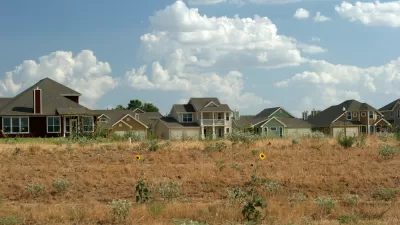An op-ed in the New York Times provides a firsthand account of the growing concern over water in a state that has yet to set limits on its explosive growth.
Richard Parker writes a dispatch from his hometown of Wimberley, Texas. "Normally, my small town is a placid place nestled in the Texas Hill Country, far from controversy, a peaceful hour’s drive west of Austin," explains Parker.
"But these are not normal times. The suburbs of Austin close in every year. Recently, the suburb of Buda and developers enlisted a company from faraway Houston to drain part of the Trinity Aquifer, the source of the Hill Country’s water. An old-fashioned, Western-style water war has erupted.
Across Texas and the Southwest, the scene is repeated in the face of a triple threat: booming population, looming drought and the worsening effects of climate change."
Parker goes on to provide a history of water's empowering effects for Texas when it is in full supply and its catastrophic effects when it disappears, as it did for "the people called the 'Ancient Ones' — the Mimbres, Mogollon, Chaco and other Native American cultures," which flourished around 800 CE and had all but disappeared by 1200 due to a prolonged drought and poor management of water resources.
Parker also notes specific examples of the "race to engineer a new solution," but while cities like Austin, San Antonio, Las Vegas, and Los Angeles hang in the balance, the question still remains whether the Southwestern United States can overcome a megadrought.
FULL STORY: The Southwestern Water Wars

Study: Maui’s Plan to Convert Vacation Rentals to Long-Term Housing Could Cause Nearly $1 Billion Economic Loss
The plan would reduce visitor accommodation by 25,% resulting in 1,900 jobs lost.

North Texas Transit Leaders Tout Benefits of TOD for Growing Region
At a summit focused on transit-oriented development, policymakers discussed how North Texas’ expanded light rail system can serve as a tool for economic growth.

Why Should We Subsidize Public Transportation?
Many public transit agencies face financial stress due to rising costs, declining fare revenue, and declining subsidies. Transit advocates must provide a strong business case for increasing public transit funding.

How to Make US Trains Faster
Changes to boarding platforms and a switch to electric trains could improve U.S. passenger rail service without the added cost of high-speed rail.

Columbia’s Revitalized ‘Loop’ Is a Hub for Local Entrepreneurs
A focus on small businesses is helping a commercial corridor in Columbia, Missouri thrive.

Invasive Insect Threatens Minnesota’s Ash Forests
The Emerald Ash Borer is a rapidly spreading invasive pest threatening Minnesota’s ash trees, and homeowners are encouraged to plant diverse replacement species, avoid moving ash firewood, and monitor for signs of infestation.
Urban Design for Planners 1: Software Tools
This six-course series explores essential urban design concepts using open source software and equips planners with the tools they need to participate fully in the urban design process.
Planning for Universal Design
Learn the tools for implementing Universal Design in planning regulations.
City of Santa Clarita
Ascent Environmental
Institute for Housing and Urban Development Studies (IHS)
City of Grandview
Harvard GSD Executive Education
Toledo-Lucas County Plan Commissions
Salt Lake City
NYU Wagner Graduate School of Public Service





























